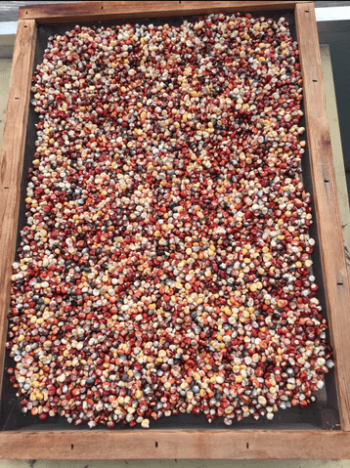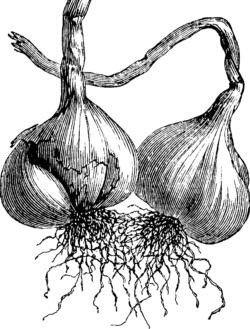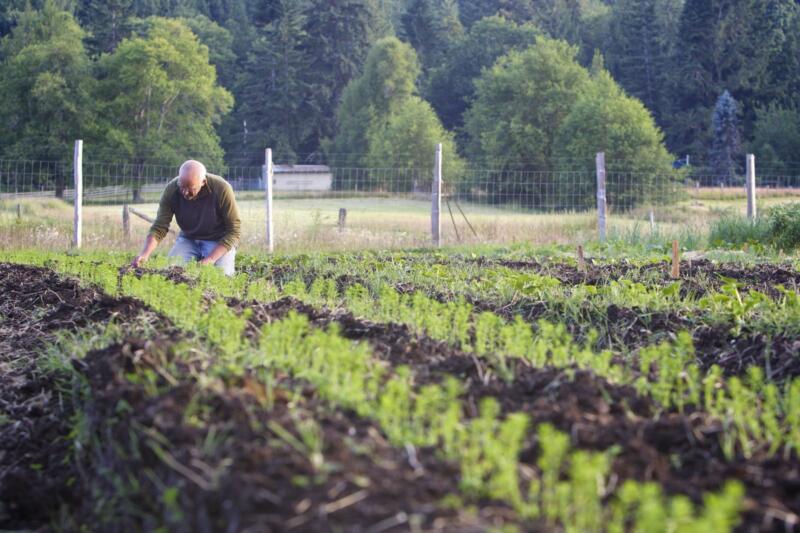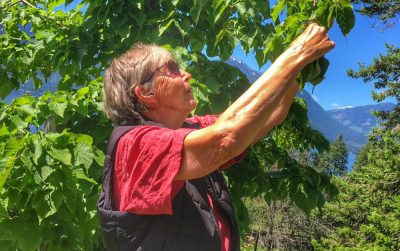1414 A seed saver’s companion
Saving Seeds: A Home Gardener’s Guide to Preserving Plant Biodiversity
by Dan Jason
Madeira Park: Harbour Publishing, 2020
$14.95 / 9781550179002
Reviewed by Luanne Armstrong
*
 This small book packs a lot of punch, much like a seed itself. I am a life long gardener, but, for various reasons, I have never been a seed saver. In part, it’s because I have more trust in seed companies than in my own ability to preserve and store seeds. In part, it’s because, once the harvesting and clean up is done, I lose interest in the garden. For me, then, it’s time to move on to writing and editing, activities that are mostly suspended through the rush of sun, heat, harvesting and summer beach going.
This small book packs a lot of punch, much like a seed itself. I am a life long gardener, but, for various reasons, I have never been a seed saver. In part, it’s because I have more trust in seed companies than in my own ability to preserve and store seeds. In part, it’s because, once the harvesting and clean up is done, I lose interest in the garden. For me, then, it’s time to move on to writing and editing, activities that are mostly suspended through the rush of sun, heat, harvesting and summer beach going.
I also love buying seeds, the trip to the nursery, the wandering through seed catalogues, handling the packages with their colourful and often misleading pictures. The flower packages are especially misleading, but in February, when I first start buying seeds, they are bright sparks of promise which I arrange together, colour by colour, before I start planting.

I wish I had had this small clearly written book by Dan Jason many years ago. I think it would have inspired me, as it will inspire gardeners now, to become a seed saver, and for many good reasons.
Dan lays out these reasons in part one and part two of the book. Dan has been a gardener, a seed saver, and a seed seller for many years, and I have always loved his sparse Salt Spring Seed catalogues with the many pages of different types of beans, among other things. Through his forty years of gardening and seed saving on Salt Spring Island, and his many years of working with seeds and plants, Dan has gained great insights into the ways of plants. I find plants, plant life, and plant conversations increasingly fascinating, and so many of Dan’s comments are enlightening.
And Dan Jason is worried about the future of seeds and gardening for some very good reasons.

As he points out, “American and Canadian governments have handed over seed research and development to transnational organizations…” and “corporate mergers of seed growers have accelerated at such a pace that there are now only a few giant rulers. Patented seeds have become common in catalogues. Plants that have always belonged to everyone are now ‘owned’ by giant corporations.”
Along with this has come genetically altered seeds. These days, “the majority of processed and animal food products in North America are now are derived from genetically modified (GMO) seeds.”
Along with GMO seeds, which are designed to resist increasing amounts of poisonous herbicides and pesticides, have come “terminator seeds,” that grow plants that cannot produce viable seeds.

Consequently, he believes, a lot of people growing a diversity of crops will be one of the key factors in the future. Dan writes. “As a grassroots movement arises to preserve and enhance our agricultural heritage … no huge grants, elaborate scientific equipment, or expensive laboratories will be required. Seeds already exist to fulfill our needs, now and into the future.”
Saving Seeds is also full of small delightful anecdotes of plants. For example, Dan has discovered, with collaborators, or encouraged into being, such plants as “Rainbow Inca corn,” created by “judicious crossings of many heritage varieties…. It is sweet but still has a lot more flavour than today’s super sweet corns that are mostly all glucose.” Every year, I grow hybridized corn but perhaps it is time to try Rainbow Inca corn. Sounds delightful!
Individual sections of this book are also devoted to saving seeds from every variety of vegetable as well as the flowers and herbs that can be grown successfully in the Canadian climate. There are also notes on seed storage, selection criteria, seed purity, and the aesthetics of seed saving, the sheer beauty of it and often, the surprises. As Dan also points out, “seeds often escape the seed saver’s attempts to collect them all. Volunteer plants … often pop up in new places. Sometimes these volunteer plants appear even earlier than greenhouse sowings, and usually they are more vigorous and better adapted than pampered transplants.”

I learned this early on in my garden and now, for example, I don’t transplant tomatoes until the volunteer tomato plants have popped up, showing me the soil is warm enough. Almost always, the volunteers catch up and pass the greenhouse plants.
Dan encourages communities to have events such as Seedy Saturdays, when people gather to sell or exchange local seed varieties. These days are a big event in my town, with more gardeners joining every year. Networking with family, friends and neighbours is also a great way to save seeds or find new varieties.
There are also seed-saving organizations devoted to saving and making available heritage seeds, such as Seeds of Diversity, or Seed Savers Exchange.
And if you buy seeds, along with seed saving, be very aware of which companies you are buying from. Many seed companies are now owned by large corporations and you can inadvertently end up with GMO seeds in your garden whether you want them there or not.

Dan also recommends that communities start their own community seed sanctuaries. The seed sanctuary on Salt Spring Island has been going now for twenty years. The saved seeds are kept in a special facility built just for them, and the seed containers are “grouped together by year and type of crop.”
I completely agree with Dan when he writes, “our lives depend on the seed and food choices we make…. we can stand up for the holiness of the earth and all its wonders. We can ardently and fearlessly learn not to buy into the greed and selfishness that threatens to destroy us. We can save the good seeds that grow healthy food while loving the web of life that makes it all possible.”
Seed saving should be part of the knowledge base of any good garden, and seed and plant exchange the basic heart of any gardening community. And Saving Seeds is a great handbook for anyone interesting in starting or continuing such a venture.

*

Luanne Armstrong has written 21 books including young adult, fiction, nonfiction, and poetry. She has contributed to many anthologies and edited Slice Me Some Truth (Wolsak and Wynn, 2011), an anthology of Canadian non-fiction. She has been nominated or won many awards, including the Moonbeam Award the Chocolate Lily Award, the Hubert Evans nonfiction Book award; the Red Cedar Award, Surrey Schools Book of the Year Award, the Sheila Egoff Book Prize, and the Silver Birch Prize. Luanne lives on her hundred year-old family farm on Kootenay Lake. She mentors emerging writers all over the world on a long-term basis, and in the last three years has edited eight books through to publication. Her most recent books are Sand (Ronsdale Press, 2016), and A Bright and Steady Flame: The Story of an Enduring Friendship (Caitlin Press, 2018; reviewed by Lee Reid). Armstrong has recently published a book of essays, Going to Ground (Caitlin Press, 2021), as well as a book of poetry, When We Are Broken (Maa Press, 2020). Editor’s note: Luanne Armstrong has recently reviewed books by Kelsey Siemens, Harold Rhenisch, Suzanne Simard, Peter Wohlleben, Wayne Sawchuk, and Katie Mitzel.
*
The British Columbia Review
Publisher and Editor: Richard Mackie
Formerly The Ormsby Review, The British Columbia Review is an on-line journal service for BC writers and readers. The Advisory Board consists of Jean Barman, Wade Davis, Robin Fisher, Cole Harris, Hugh Johnston, Kathy Mezei, Patricia Roy, Maria Tippett, and Graeme Wynn. Provincial Government Patron (since September 2018): Creative BC. Honorary Patron: Yosef Wosk. Scholarly Patron: SFU Graduate Liberal Studies.
“Only connect.” – E.M. Forster